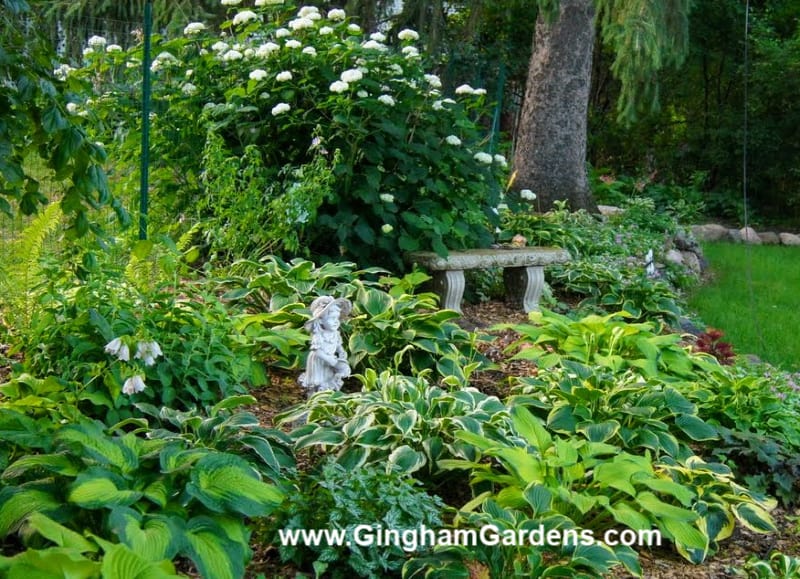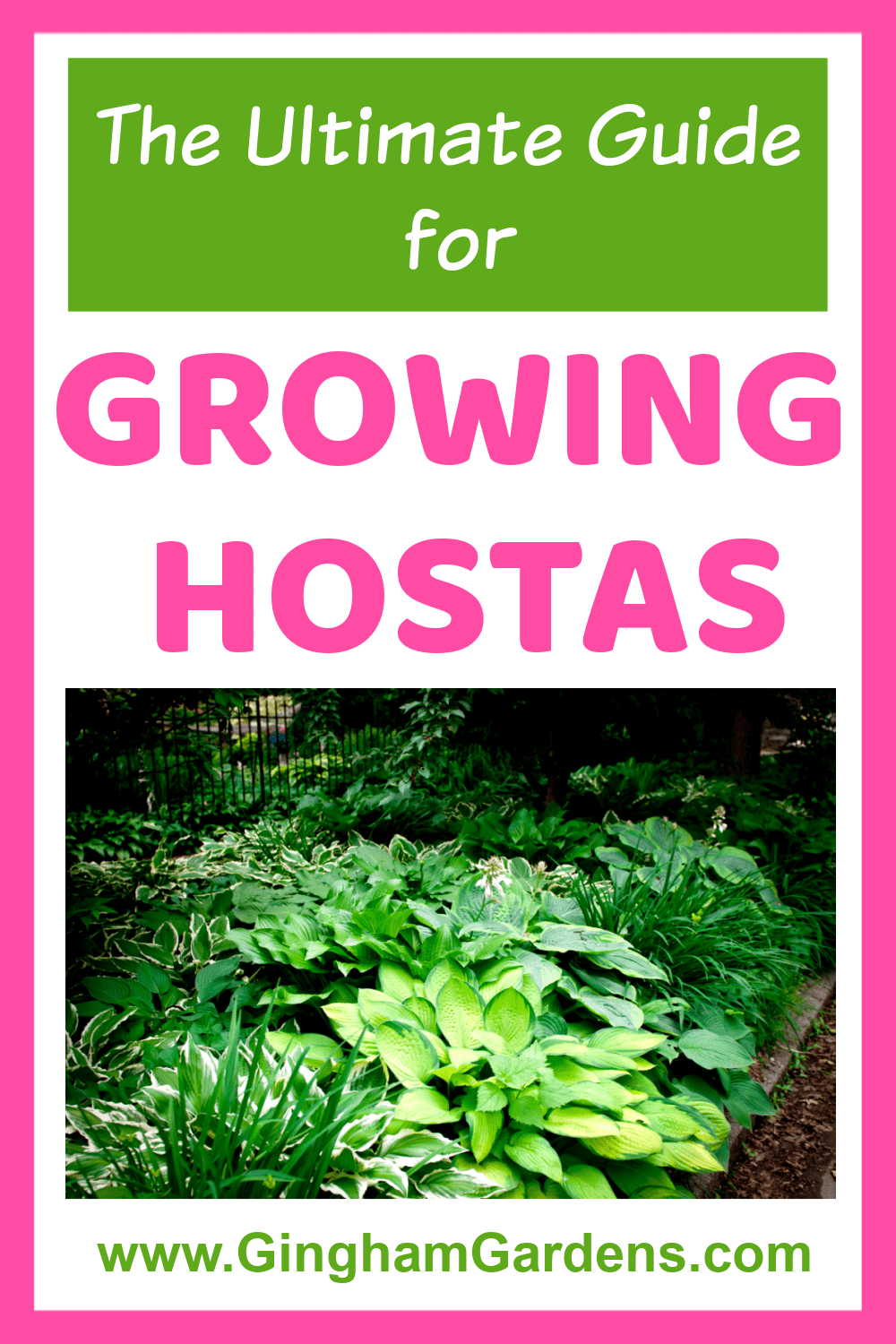Growing Hostas (The Ultimate Guide)
Before I had shade gardens, I thought of hostas as boring shade garden plants. Now that I have lots of shade, I’m embracing growing hostas and all the beautiful varieties that are available. Yes, there are still many plain-Jane hostas, like Royal Standard, lancifolia and the common variegated green ones that other gardeners give away. If you have some of those plain-Jane varieties, I encourage you to look beyond those and start adding some different cultivars to your shade garden. In a few years, your hosta garden will be stunning.
My friend, Julie’s hosta garden.
Although hostas aren’t native to North America, when they flower, they will attract bees to your shade gardens. With the exception of a few varieties, I typically cut the flowers off my hostas. I’ve got plenty of other flowers for the bees to love on.
I can’t write a post about growing hostas without sharing lots of pictures of some of the hostas in my garden. And so, I will intersperse hosta images throughout the post. The variety names are under the pictures. Enjoy!
This post contains affiliate links. If you click on
one of the links and make a purchase,
I may receive a small commission at no additional cost to you.
See full disclosure here.
Different Types of Hosta
There are literally thousands of cultivars available to home gardeners. And, I only have around 50 – 60 varieties in my gardens. Oh, wait a minute, I have around 15 new hostas to plant, so that bumps that number up. Since I’m a garden nerd, I really like to keep a list in my garden journal of the different hosta varieties I have in my gardens. If you’re a collector of hostas, do you keep track of the varieties you have?
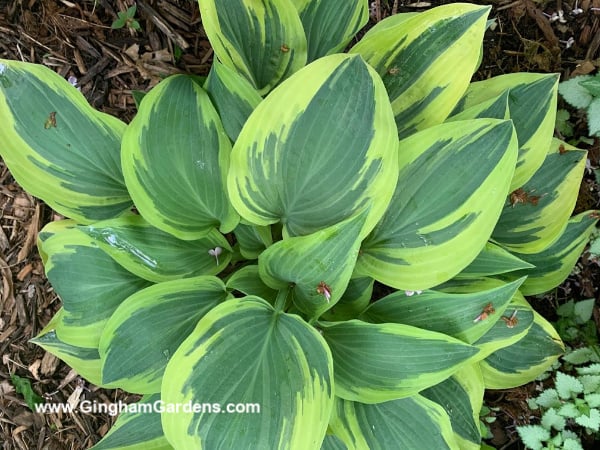
Hosta plants are typically grown for their foliage, although they do flower in late summer. Some of the flowers are interesting and some are fragrant. The flowers make wonderful additions to bouquets and so do the leaves for that matter. The leave textures of hostas are amazing; there are veined leaves, some are puckered, many are smooth, some are wavy, and the list goes on and on.
Hostas also come in about every shade of green you can imagine. There’s chartreuse green, blue green, very light green (almost white), lime green, variegated, etc. etc.

Different Sizes of Hosta
There are basically 5 different sizes of hosta. They are categorized based on their height when they are full grown.
- Giant – Greater than 28 inches tall – Some popular examples of Giant Hostas are Sum and Substance and Empress Wu.
- Large – 18 – 28 inches tall – Some examples of large hostas are Abiqua Drinking Gourd, Great Expectations and Paradigm.
- Medium – 10 – 18 inches tall – A few examples of medium hostas are Golden Standard, Halcyon, Night Before Christmas, Rainbow’s End and Queen Josephine.
- Small – 6 – 10 inches tall – Examples of small hostas include: Golden Tiara, Wrinkle in Time and Fantasy Island.
- Miniature – Less than 6 inches – Some examples of miniature hostas are Pandora’s Box, Curly Fries and Blue Mouse Ears.

Hosta of the Year List
In 1996, the American Hosta Growers Association began awarding a Hosta of The Year. They came up with this award to help gardeners and nursery owners select the best hostas for their gardens and garden centers from the crazy number of hosta cultivars being introduced each year. The hostas that are selected to win the Hosta of the Year award work well in all gardening zones and are widely available.
- 2021 – Rainbow’s End
- 2020 – Dancing Queen
- 2019 – Lakeside Paisley Print
- 2018 – World Cup
- 2017 – Brother Stefan
- 2016 – Curly Fries
- 2015 – Victory
- 2014 – Abiqua Drinking Gourd
- 2013 – Rainforest Sunrise
- 2012 – Liberty
- 2011 – Praying Hands
- 2010 – First Frost
- 2009 – Earth Angel
- 2008 – Blue Mouse Ears
- 2007 – Paradigm
- 2006 – Stained Glass
- 2005 – Striptease
- 2004 – Sum and Substance
- 2003 – Regal Splendor
- 2002 – Guacamole
- 2001 – June
- 2000 – Sagae
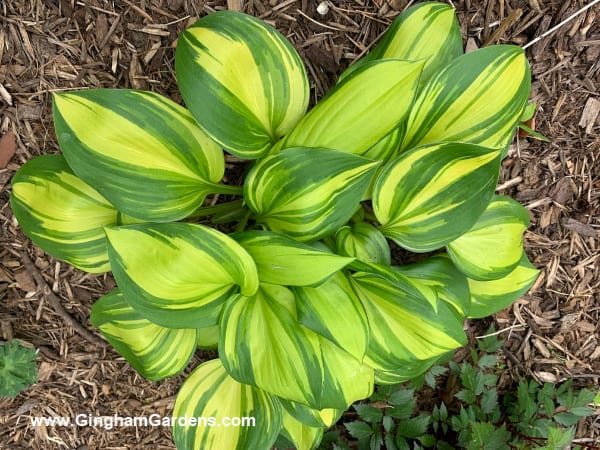
Growing Hostas – Care and Maintenance
Hostas are a low maintenance perennial. That being said there are a few things you can do to keep your hostas looking great the entire season. First of all, hosta plants work much better as shade plants. Some hostas do okay with a bit of morning sun, but they are definitely not full sun plants. Yes, you can plant them in full sun, but by July (even here in zone 4) they will be fried and looking pretty awful. If you still want to try hostas in a sunny spot, the lighter colored varieties seem to handle the sun better.
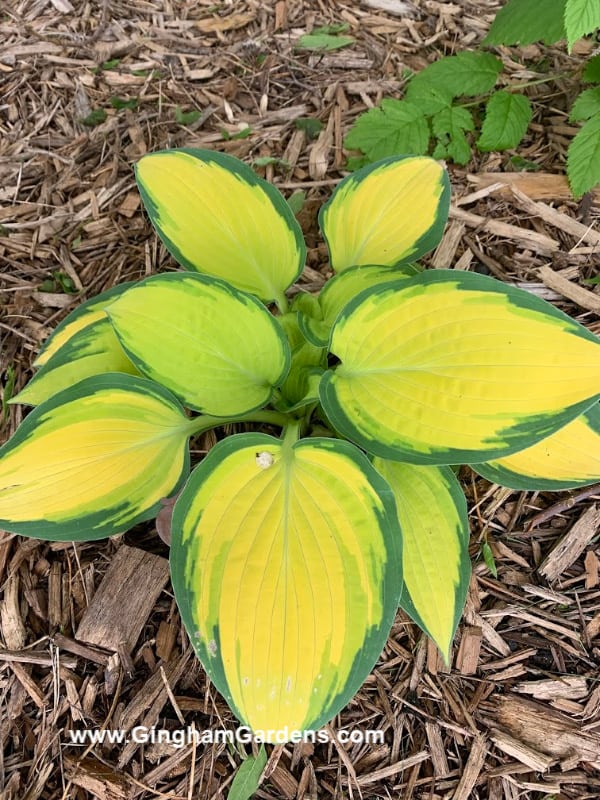
Of course, as with most perennials, hostas like to grow in rich, fertile soil that drains well. The soil in my shade areas is not great, but I’m working on it with leaf mulch and compost. The hostas in my gardens are still flourishing and I don’t fertilize my hostas at all.
What About Dividing Hosta Plants
It isn’t necessary to divide hosta plants at all, but if you want to control the size, share the goodness, or spread them to other areas of your yard, it’s very easy to divide them. It works best to divide hostas in the spring or fall (at least six weeks before the first frost).
I usually divide them in the spring right when they are emerging from the ground, before the leaves unfurl. Dividing in the spring means less damage to the leaves and they aren’t as likely to show signs of transplant shock.
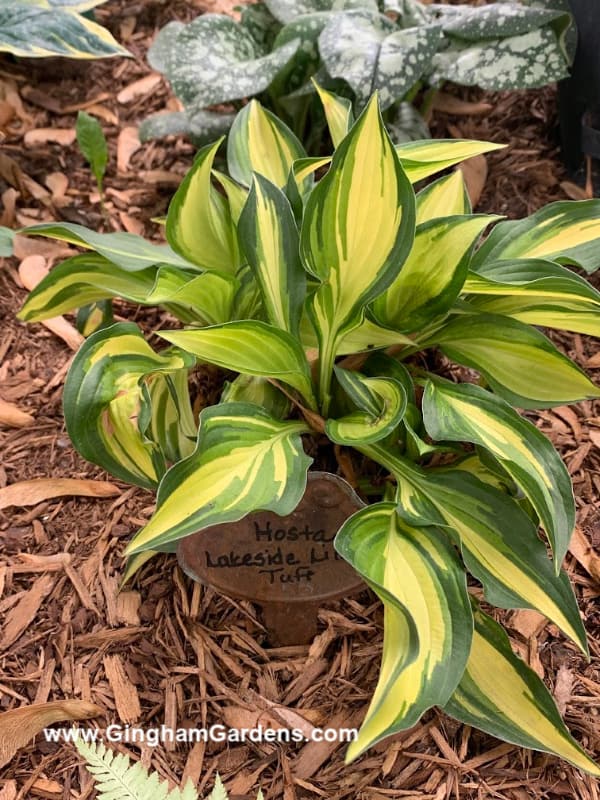
It also works well to divide and transplant hosta plants in the fall too. That way they are ready to go the next spring. Just be sure to do so at least six weeks before your first frost so they have a chance to settle in and the roots get established. If you need more information on transplanting and dividing perennials in general, you’ll learn everything you need in the post.
Hosta Pest Problems
Although they are super easy to grow and maintain, many varieties of hosta are susceptible to slug damage. I’ve tried all kinds of remedies like crushed egg shells and beer traps, but the thing that works best is a product called Sluggo. Sluggo is an organic granular product that is safe for use around wildlife and pets. I sprinkle Sluggo around the base of each hosta plant in the spring when the plants are first emerging and again around the middle to the end of June. I find I have much less slug damage when I repeat the application.
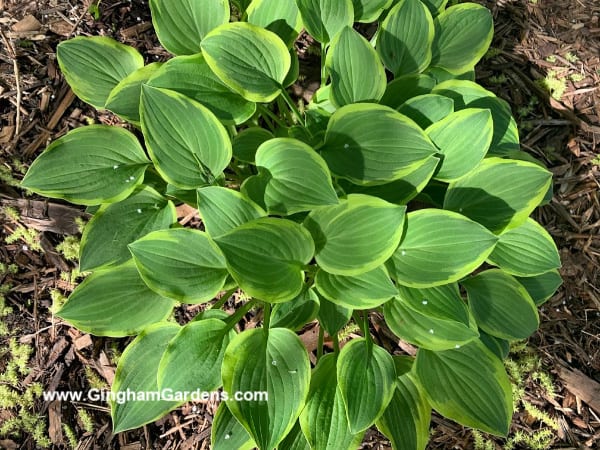
Unfortunately, hosta gardens are quite appetizing to deer and rabbits. There’s nothing more aggravating to go out to the gardens and see that a rabbit has passed through and had a snack out of several hostas. I don’t have deer in my gardens now, but I have in the past.
Here’s the combination that has worked the best for me – Milorganite (actually an organic fertilizer), Liquid Fence and Deer Out. Sprinkle a border of Milorganite around your shade garden in the early spring, and then again every 2 – 3 weeks (depending on rain fall). I also spray Liquid Fence around the gardens in early spring and every 2-3 weeks thereafter. If I have a really bad problem, I alternate Liquid Fence and Deer Out.
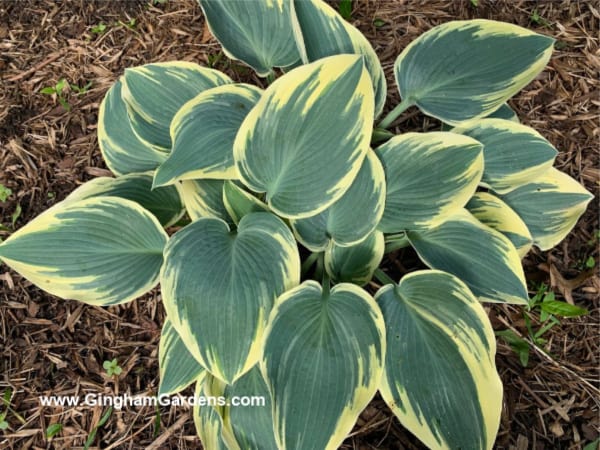
I know that sounds like a lot of work for a low maintenance plant, but it doesn’t take much time at all and protecting your beautiful perennials is worth it to not have a garden full of munched on plants.
Tips for Purchasing Hostas Online
I recommend supporting your local garden centers before shopping online. However, I have found that there are so many varieties of hosta available that if I want something different, I need to look online. Here are some tips for online shopping:
- Purchase from a reputable grower and read reviews.
- I don’t recommend buying seeds online. Especially if you see a picture of purple hostas or some other off color.
- Look for online sellers in your gardening zone.
- Be aware that when shopping online, you will not get a full sized plant. A hosta plant sold online will likely come as a bare root plant, or a small potted plant.
- It takes about 3 years for a bare root or small division plant to reach its full size.
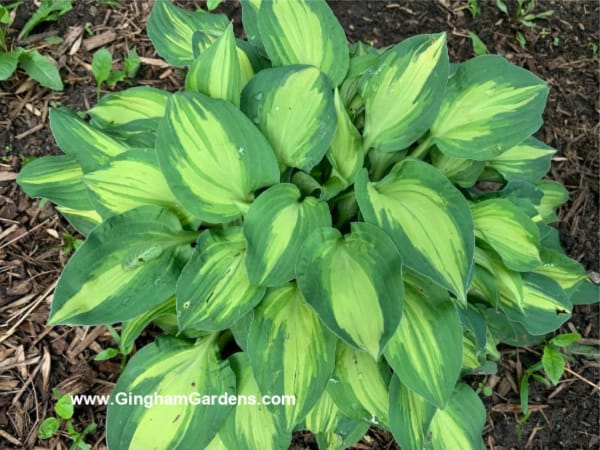
There are many hosta sellers on Etsy. Yes, I have purchased plants on Etsy and have very good success with them. This seller has lots of beautiful hostas at reasonable prices, plus free shipping and gets 5 star reviews.
This is another hosta seller on Etsy that has beautiful plants with excellent reviews. His shipping rates seem a little high, but he’s great to work with and will refund shipping costs to you once the order is packed and he knows the true cost of shipping.
Willard and May sells a bare root mix of hostas on Amazon and they get great reviews. I also like to order online from Gilbert H. Wild and Bluestone Perennials. Although the plants are small, they always take off once planted in my gardens.
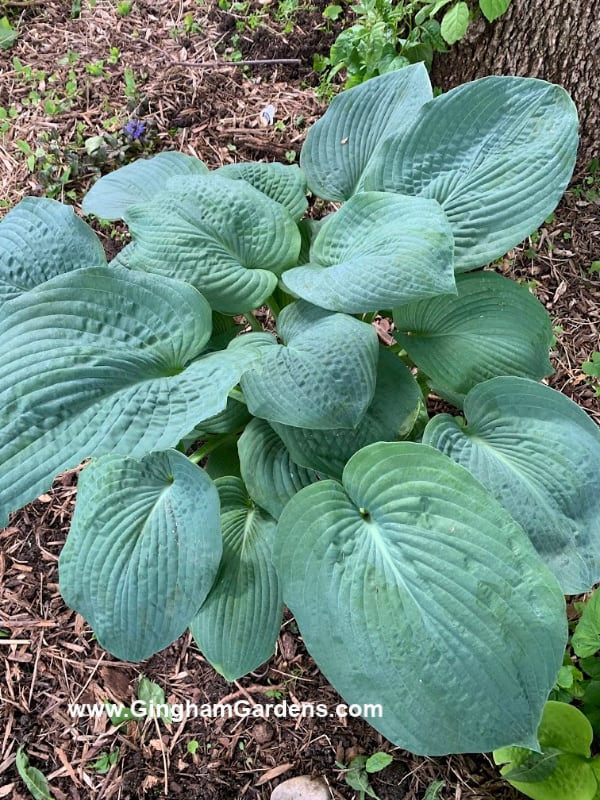
A Few Other Tips for Growing Hostas
Because I’m a garden geek, I love to use plant tags so I know the names of all my hostas. Since I collect hostas, I like to have fancy plant tags like these. I love these plant tags even though they are a bit spendy. They will last forever and look really great too. Always use a good paint marker on your plant tags and not a permanent marker. The paint markers will last, but permanent markers do not last outdoors.
The New Encyclopedia of Hostas looks amazing and just the perfect book for hosta lovers. It’s going on my wish list!
More Hosta Images
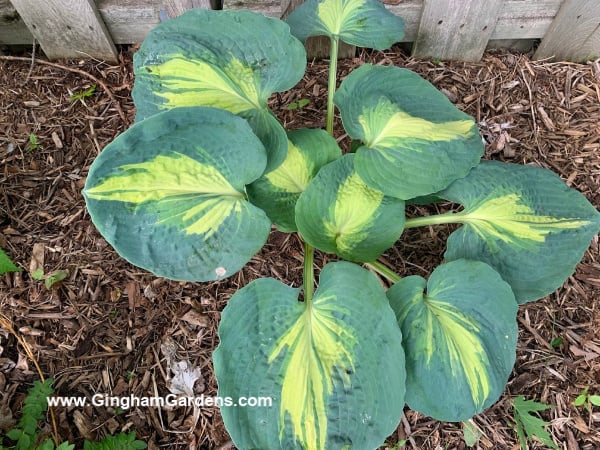

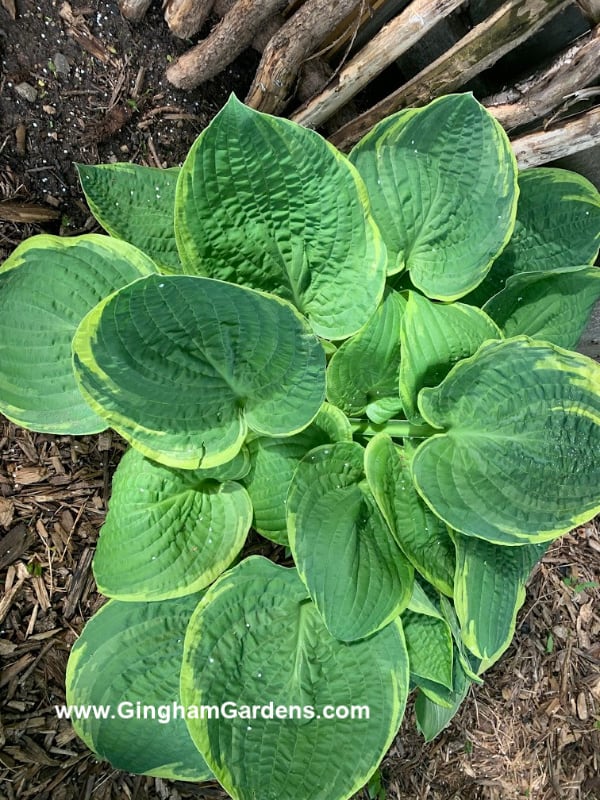
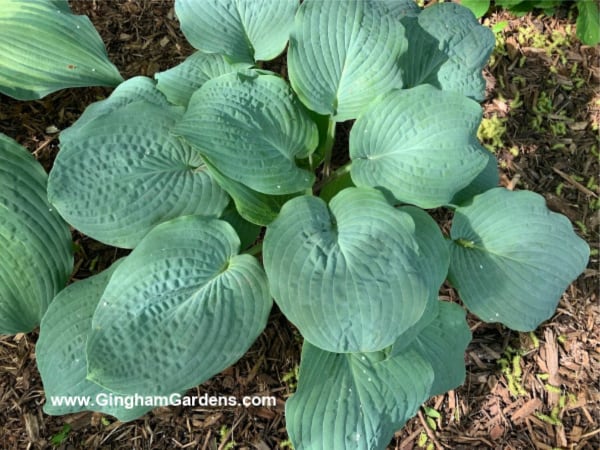
Here are some other posts I think you’ll enjoy:
20 Perennials for Shade to Jazz Up Your Gardens (shade plants other than hostas)
Made in the Shade Gardens
The American Hosta Society is an amazing resource for growing hostas, as well as lots and lots of hosta images.
Thanks so much for stopping by Gingham Gardens today. I hope you enjoyed the pictures and tips on growing hostas. If you have questions, or comments, please feel free to complete the comment form at the end of the post. I love hearing from and helping my readers with their gardening questions.
Happy gardening,
Joanna
Pins to share:

